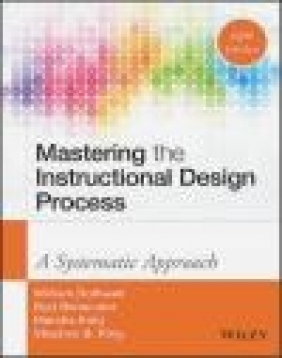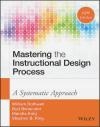Mastering the Instructional Design Process
H. C. Kazanas, Stephen King, Marsha King
Mastering the Instructional Design Process
H. C. Kazanas, Stephen King, Marsha King
- Wydawnictwo: John Wiley
- Rok wydania: 2016
- ISBN: 9781118947135
- Ilość stron: 432
- Oprawa: Twarda
Niedostępna
Opis: Mastering the Instructional Design Process - H. C. Kazanas, Stephen King, Marsha King
A comprehensive framework for effective real-world instructional design Mastering the Instructional Design Process provides step-by-step guidance on the design and development of an engaging, effective training program. The focus on core competencies of instructional system design helps you develop your skills in a way that's immediately applicable to real-world settings, and this newly updated fifth edition has been revised to reflect the new IBSTPI Competencies and Standards for Instructional Design. With a solid foundation of researched and validated standards, this invaluable guide provides useful insight and a flexible framework for approaching instructional design from a practical perspective. Coverage includes the full range of design considerations concerning the learners, objectives, setting, and more, and ancillaries include design templates, PowerPoint slides, lecture notes, and a test bank help you bring these competencies to the classroom. Instructional design is always evolving, and new trends are emerging to meet the ever-changing needs of learners and exploit the newest tools at our disposal. This book brings together the latest developments and the most effective best practices to give you a foolproof framework for successfully managing instructional design projects. * Detect and solve human performance problems * Analyze needs, learners, work settings, and work * Establish performance objectives and measurements * Deliver effective instruction in a variety of scenarios Effective training programs don't just happen. Instructional design is a complex field, and practitioners must be skilled in very specific areas to deliver a training program that engages learners and makes the learning 'stick.' Mastering the Instructional Design Process is a comprehensive handbook for developing the skillset that facilitates positive training outcomes.Preface to the Fifth Edition xiii Acknowledgments xix About the International Board of Standards for Training, Performance, and Instruction xxi Advance Organizer xxiii About This Book xxvii PART ONE: OVERVIEW 1 1 An Overview of Instructional Design 3 Instructional Design: An Emerging Profession 4 Instructional Design: Focused on Establishing and Maintaining Efficient and Effective Human Performance 5 Instructional Design: Guided by a Model of Human Performance 7 Instructional Design: Carried Out Systematically 11 Instructional Design: Based on Open Systems Theory 11 Instructional Design: Oriented to Finding and Applying the Most Cost-Effective Solutions to Human Performance Problems 13 Criticisms of Traditional Instructional Approaches 14 PART TWO: PLANNING AND ANALYZING FOR INSTRUCTIONAL DESIGN 17 2 Conducting a Needs Assessment 19 Defining Terms 23 Steps in Developing Needs Assessment 29 Developing a Needs Assessment Plan: A Case Study 35 Solving Problems in Conducting Needs Assessments 36 Identifying Instructional Problems 38 Ethical Issues in Needs Assessment 38 3 Collecting and Analyzing Data for Instructional Design Projects 41 The Nature of Data 41 The Data Collection Process 45 Data Analysis 58 4 Identifying the Target Population and Environmental Characteristics 61 Selecting Learner Characteristics for Assessments 62 Selecting Learner Characteristics: A Case Study Example 71 When Should Learner Characteristics Be Assessed? 73 5 Using Analytical Techniques to Determine Instructional Content 90 Identify Content Aligned with Needs Assessment Findings 91 Elicit, Synthesize, and Validate Content from Subject Matter Experts 91 Analyze Instructional Products to Determine the Adequacy of Content, Instructions, and Learning to Determine Content Coverage 92 Determine Subordinate and Prerequisite Skills and Knowledge 93 Analyze Content 97 6 Analyzing the Potential Use of Existing and Emerging Technologies 98 E-Learning 100 The Effectiveness of Today s Instructional Technology 110 PART THREE: DESIGNING AND DEVELOPING FOR INSTRUCTIONAL DESIGN 117 7 Using an Instructional Design Process Appropriate for a Project 119 Selecting or Creating an Instructional Design Process Based on the Project 123 Modifying the Instructional Design Process as Project Parameters Change 123 Describing a Rationale for the Selected, Created, or Modified Instructional Design Process 124 8 Organizing Instructional Programs and/or Products 125 Determine the Overall Scope of Instructional Programs 125 Specify and Sequence the Anticipated Learning and Performance Outcomes 138 9 Designing Instructional Interventions 145 Identifying Instructional Strategies Aligned with Instructional Goals and Anticipated Learning Outcomes 149 Choosing an Appropriate Instructional Strategy 155 Choosing Media and Delivery Methods 159 Selecting Delivery Modes 162 Appreciating the Learner s Perspective: A Brief Overview of Cognitive Strategies 164 Using Appropriate Message, Visual, and Motivational Design Principles 165 Accommodating Social, Cultural, Political, and Other Individual Factors Influencing Learning 169 10 Planning Noninstructional Interventions 171 Identifying Appropriate Noninstructional Interventions 172 Feedback Options 173 Job Performance Aids 176 Reward Systems 179 Employee Selection Practices 181 Organizational Redesign 184 Justifying Appropriate Noninstructional Interventions 187 Creating Design Specifications for Noninstructional Interventions 188 11 Selecting or Modifying Existing Instructional Materials 189 Selecting, Developing, or Modifying Instructional Materials 189 Conducting Cost-Benefit Analyses to Decide Whether to Use or Modify Existing Materials 194 Validating Selection or Modification of Existing Instruction 195 12 Developing Instructional Materials 196 Developing Media Specifications 196 Producing Instructional Materials in Various Delivery Formats 213 Developing Materials Aligned with Content Analysis, Proposed Technologies, Delivery Methods, and Instructional Strategies 214 Collaborating with Production Specialists 214 13 Designing Learning Assessments 215 Introduction 215 An Overview of Steps in Preparing Instruments 221 Constructing Reliable and Valid Methods of Assessing Learning and Performance 228 Ensuring the Assessment Is Aligned with Instructional Goals, Anticipated Learning Outcomes, and Instructional Strategies 229 PART FOUR: EVALUATING AND IMPLEMENTING INSTRUCTIONAL DESIGN 231 14 Evaluating Instructional and Noninstructional Interventions 233 Purpose and Definitions of Evaluation 234 Formative Evaluation 239 Developing a Formative Evaluation Plan 240 Four Major Approaches to Conducting Formative Evaluation 246 Summative Evaluations 251 Reporting Evaluation Results 259 Creating the Report 261 Disseminating the Report 262 15 Revising Instructional and Noninstructional Solutions Based on Data 263 Types of Revisions 264 Gaining Stakeholder Support for Revisions 267 Implementing Revisions to Delivery of Products/Programs 269 16 Implementing Instructional and Noninstructional Interventions 271 Creating a Vision for Change 272 Planning for the Implementation and Dissemination of the Intervention 276 Planning for Diffusion of the Intervention 285 Encouraging and Achieving Adoption and Buy-In 285 Compliance versus Gaining Commitment 286 Monitoring Implementation, Dissemination, and Diffusion to Identify Potential Adjustments 287 Taking Action on Deviations or Problems Surfaced through Monitoring 288 PART FIVE: MANAGING INSTRUCTIONAL DESIGN 289 17 Applying Business Skills to Managing the Instructional Design Function 291 Where Instructional Design Fits into the Larger Organization 292 Contributing to the Organizational Purpose and Strategy 295 Implementing Standards 299 Leveraging Internal and External Resources to Accomplish Project Goals and Objectives 301 Managing Instructional Design Talent 303 Marketing and Communicating about Instructional Design 313 Navigating Organizational Culture, Structure, Politics, and Processes 314 18 Managing Partnerships and Collaborative Relationships 317 Identifying and Engaging Stakeholders 318 Building Relations between Instructional Designers and Individuals or Group Members 322 Managing Cross-Functional Teams 327 Securing Commitment 331 Conducting Project Reviews 333 19 Planning and Managing Instructional Design Projects 334 Unique Challenges Posed by Project Management 335 Allocating Resources to Support the Project Plan 338 PART SIX: PREDICTING THE FUTURE OF INSTRUCTIONAL DESIGN 341 20 Predicting the Future of Learning and Instructional Design 343 Technological Advances to Improve Delivery and Design 343 The Impact of Neuroscience Research on Instructional Systems Design 357 A Final Word 361 About the Authors 363 References 367 Index 382
Szczegóły: Mastering the Instructional Design Process - H. C. Kazanas, Stephen King, Marsha King
Tytuł: Mastering the Instructional Design Process
Autor: H. C. Kazanas, Stephen King, Marsha King
Wydawnictwo: John Wiley
ISBN: 9781118947135
Rok wydania: 2016
Ilość stron: 432
Oprawa: Twarda
Waga: 0.86 kg






























